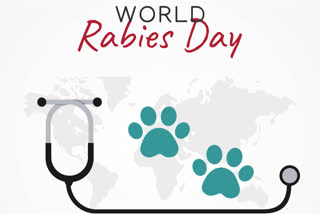Rabies is a virus that can spread with the bite from an infected animal and not just a dog. Every year on 28th September, World Rabies Day is observed in order to spread awareness about this disease and to work in order to prevent it completely. It was first observed in 2007 and this year marks the 14 years of its celebration worldwide. The theme this year is “End Rabies: Collaborate, vaccinate”. According to the World Health Organisation, rabies is estimated to cause 59 000 human deaths annually in over 150 countries, with 95% of cases occurring in Africa and Asia.
What Is Rabies?
The Centers for Disease Control and Prevention (CDC) explains Rabies is a fatal but preventable viral disease. It can spread to people and pets if they are bitten or scratched by a rabid animal. In the United States, rabies is mostly found in wild animals like bats, raccoons, skunks, and foxes. However, in many other countries dogs still carry rabies, and most rabies deaths in people around the world are caused by dog bites.
Symptoms Of The Disease
The Global Alliance for Rabies Control (GARC) explains the symptoms of Rabies that might be presented by the person who has been infected with the virus.
“Immediately after transmission of the virus (e.g. through a bite), there are no symptoms. The virus then travels through the nervous system, again without causing any symptoms, until it reaches the brain. Once in the brain (usually 1-3 months after the bite), the virus causes a variety of non-specific problems: general malaise, fatigue, headache, and general weakness or discomfort. There may also be discomfort or a prickling or itching sensation at the site of the bite. As the brain infection progresses, more specific symptoms are apparent and include insomnia, anxiety, confusion, slight or partial paralysis, excitation, hallucinations, agitation, hypersalivation (increase in saliva), difficulty swallowing, and hydrophobia (fear of water). Eventually, the patient falls into a coma and dies”.
Can The Transmission Occur From Person To Person?
GARC states that Bites or and contact with saliva from a person infected with rabies during the symptomatic stage of the disease could theoretically transmit rabies, and people who have been exposed to rabies patients should be offered post-exposure prophylaxis. It may be possible to transmit the virus from a symptomatic rabies patient through mouth-to-mouth contact or kissing. The virus has been reported to be present in sperm or vaginal secretions, so transmission through sexual intercourse with an infected person may be possible. Oral sex with a person infected with the rabies virus may also carry a risk
Casual contact with a person infected with symptomatic rabies (touching unbroken skin or contact with non-infectious tissues or bodily fluids) cannot transmit the rabies virus to another person.
If you have risky contact with an infectious person 14 days prior to the onset of clinical symptoms, post-exposure prophylaxis is recommended. Risky behaviors include bites, kisses, or other direct contacts between saliva and mucous membranes or broken skin, sexual activity, and sharing eating or drinking utensils or cigarettes.
Prevention
Since the disease is mostly fatal, therefore, prevention is better. CDC recommends the following tips on preventing the disease in both animals in humans.
In Pets
- Visit your veterinarian with your pet on a regular basis and keep rabies vaccinations up-to-date for all cats, ferrets, and dogs.
- Maintain control of your pets by keeping cats and ferrets indoors and keeping dogs under direct supervision.
- Spay or neuter your pets to help reduce the number of unwanted pets that may not be properly cared for or vaccinated regularly.
- Call animal control to remove all stray animals from your neighborhood since these animals may be unvaccinated or ill.
In Humans
- Leave all wildlife alone, including injured animals. If you find an injured animal, don’t touch it; contact local authorities for assistance.
- Know the risk. Find out if rabies is present in dogs or wildlife at your destination before international travel.
- Wash animal bites or scratches immediately with soap and water.
- If you are bitten, scratched, or unsure, talk to a healthcare provider about whether you need post-exposure prophylaxis. Rabies in people is 100% preventable through prompt appropriate medical care.
- Vaccinate your pets to protect them and your family.
The major burden of this disease is borne by the rural population and children under the age of 15 years. Many countries are working on it and hopefully, soon we will be able to get rid of it. Therefore, rabies is a serious condition faced by many countries, and combined steps to prevent and eradicate the disease completely should be taken.
